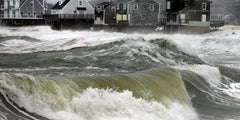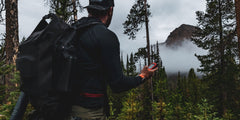
In this blog post, we'll discuss an often underestimated threat to outdoor enthusiasts—flash flooding. Whether you're a hiker, backpacker, kayaker, hunter, fisherman, or simply enjoy outdoor exploration, it's crucial to be aware of flash flood safety. Flash floods claim more lives each year than any other extreme weather event. Let's delve into key tips to ensure your safety in such situations.
Plan Ahead:
Consider specific conditions that increase the risk of flash flooding, such as unusually heavy rain over several hours, steady rain over several days, spring thaw combined with rain, or the influence of a monsoon or tropical system. If these conditions exist, it's advisable to postpone your trip to the affected area. Stay informed by contacting local weather stations or park services to obtain safety information, potential dangers, risks, or area closures.
Familiarize yourself with the terms used by the National Weather Service (NWS) and the National Oceanic and Atmospheric Administration (NOAA) for flash flood alerts:
- Flash Flood Watch: Indicates that conditions are favorable for flash flooding, covering several counties. Start considering your plan of action and identify higher ground in case water levels rise.
- Flash Flood Warning: Issued when dangerous flash flooding is imminent or ongoing in a specific area. Act swiftly as flash floods pose an immediate threat. You may have mere seconds to move to higher ground.
- Flash Flood Emergency: An exceedingly rare alert indicating an imminent threat to human life and catastrophic damage from a flash flood. Emergency officials report life-threatening water rises, necessitating water rescues and evacuations.
Check the Weather:
Always check the weather forecast before embarking on any outdoor activity. Remember that lightning can travel up to 10 miles from a storm system, and flash floods can affect areas up to 100 miles away. Flash floods can occur very rapidly as well, often within minutes or even seconds.
Know Your Route:
Understanding the elevation and topography of your intended destination is vital for flash flood safety. Determine whether you'll be at higher elevations or in canyons, as this knowledge informs your risk assessment and helps you identify the best escape routes from potential dangers. Additionally, be aware of nearby dams or levees and whether you are upstream or downstream of these landmarks.

Pay Attention to Your Surroundings:
Lower-lying areas, such as canyons, gullies, rivers, streams, dry riverbeds, runoff zones, and ravines, present a higher risk of flash flooding. These areas can quickly fill with water, even if the storm responsible is far away. Stay vigilant and evacuate immediately if you notice a dry riverbed filling with water or if a stream or river turns muddy or cloudy. Listen for auditory cues, such as loud roaring, which may signal an approaching wall of water. Climb to higher ground without hesitation.
River Safety:
While bodies of water can be alluring, it's essential to exercise caution:
-
Avoid camping near rivers, streams, or watershed areas, as they can rapidly fill with water during the night.
-
Just six inches of flowing water can sweep a person off their feet and carry them downstream.
-
Flooding can occur suddenly, within seconds, minutes, or over an hour. Don't take chances—evacuate immediately if conditions change.
-
Be particularly cautious at night when spotting floods can be more challenging.
Crossing Streams Safely:
When crossing a stream during a hike, follow these steps:- Assess the situation once everyone in your party has reached the stream.
- Avoid walking through a flowing stream where water is above your ankles.
- Loosen pack buckles while walking on rocks or logs over a stream, allowing you to quickly escape from your pack if you fall.
- Ensure everyone has crossed safely before continuing.
- Uncharted Bonus: Use the Seventy2 or Seventy2 Pro shell as a supporting floatation device when crossing deeper streams.

Leaving the Area:
- If you're caught in a thunderstorm with flash floods, move to higher ground: If you notice any signs of a flash flood, do not attempt to cross a flooded area or wait for the water to recede. Do not try to outrun the flood: Flash floods can move swiftly, but it is crucial not to attempt to outrun them on foot. The force of the water is often stronger than it appears, and you risk being swept away. Focus on finding safe, higher ground instead.
After the Flood:
- Be cautious after the floodwaters recede, as they may have damaged bridges and roadways. If you're unsure about the safety or integrity of a road, do not attempt to cross. Inform friends, family, Search and Rescue, or local park rangers of your location if you become trapped. Maintain communication and follow their advice for a safe evacuation.:
As outdoor adventurers, we must respect nature's power and take responsibility for our safety. By following these flash flood safety tips, you can better prepare yourself and minimize the dangers associated with outdoor exploration. Stay safe, stay alert, and cherish your outdoor adventures this summer.





